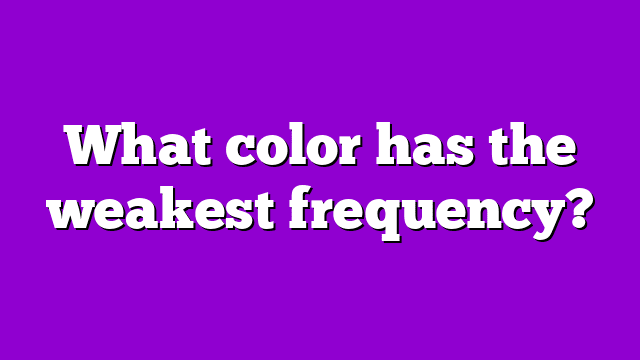Crystal Basics & Properties
What color has the weakest frequency?
The color with the weakest frequency is red. Red has the longest wavelength and the lowest frequency of all the visible colors. On the other hand, the color with the most frequency is violet. Violet has the shortest wavelength and the highest frequency of all the visible colors.
To understand the concept of frequency in colors, we need to dive into the science of light. When white light passes through a prism, it refracts and splits into the seven visible colors: red, orange, yellow, green, blue, indigo, and violet. Each of these colors has a different wavelength, which determines its frequency.
• Red: Red has the longest wavelength among all visible colors, ranging from about 630-750 nanometers. It has the weakest frequency and is associated with the root chakra, which governs stability, grounding, and physical needs.
• Violet: Violet has the shortest wavelength among all visible colors, ranging from about 380-450 nanometers. It has the highest frequency and is associated with the crown chakra, which governs spirituality, enlightenment, and cosmic consciousness.
Other colors fall in between these frequencies, with orange, yellow, and green being less frequency-dense than blue and indigo. Understanding the frequency of colors can be helpful when using them for healing and spiritual purposes, such as choosing the right crystals for energy balance or using color visualization during meditation.
Table Of Contents
The science behind color frequency
Color is not just a visual sensation, but also a form of energy that has a measurable frequency. Each color has a unique frequency, and this frequency determines how the color is perceived by our eyes and brains. Color frequency is an important concept in both science and spirituality, and understanding it can help us to harness the power of color for healing and manifestation.
Understanding the electromagnetic spectrum
Color frequency is part of the electromagnetic spectrum, which includes all types of electromagnetic radiation, from radio waves to gamma rays. The electromagnetic spectrum is divided into different bands based on the wavelength and frequency of radiation. Visible light, which is the part of the spectrum that humans can see, falls within a narrow wavelength range between 400 and 700 nanometers (nm). Within this range, different colors have different wavelengths and frequencies, with violet having the shortest wavelength and highest frequency, and red having the longest wavelength and lowest frequency.
The meaning behind colors in spirituality
In spirituality, colors are often associated with different meanings and properties. For example, red is associated with passion and energy, while blue is associated with calmness and communication. These associations are not just arbitrary; they are rooted in the vibrational energy of each color. When we see a certain color, we are not just seeing a visual sensation, but also experiencing the energy and vibration of that color.
Colors and their vibrational energy
Each color has a unique vibrational energy that affects our physical, emotional, and spiritual well-being. Vibrational energy is a measure of the frequency and amplitude of a wave, and it is what determines how strongly a color affects us. Colors with higher frequencies and amplitudes have stronger vibrational energy, while colors with lower frequencies and amplitudes have weaker vibrational energy.
Which color has the weakest frequency?
The color with the weakest frequency is red, which has a frequency of about 400 THz (terahertz). This is because red has the longest wavelength of all the visible colors, which means it has lower frequency and vibrational energy. Despite its weak frequency, however, red is still a powerful and energizing color that can stimulate the body and mind.
Which color has the strongest frequency?
The color with the strongest frequency is violet, which has a frequency of about 700 THz. Violet has the shortest wavelength of all the visible colors, which means it has the highest frequency and vibrational energy. Because of its high frequency, violet is often associated with spirituality, intuition, and higher consciousness.
How to use colors for healing and manifestation
Colors can be used for healing and manifestation by harnessing their vibrational energy and properties. Here are some tips for using colors in this way:
– Choose colors that correspond to your desired outcome. For example, if you want to feel more calm and centered, wear blue or surround yourself with blue objects.
– Visualize yourself surrounded by the color that corresponds to your desired outcome. Close your eyes and imagine a bright, glowing ball of that color surrounding you, filling you with its energy and vibrational frequency.
– Use gemstones and crystals that correspond to specific colors. Each gemstone has a unique vibrational energy that can enhance the properties of the corresponding color. For example, amethyst is a purple gemstone that corresponds to the color violet, and is often used for spiritual and intuitive purposes.
– Wear clothing or accessories in the corresponding color. This can help you to absorb the vibrational energy of the color throughout the day.
In conclusion, color is not just a visual sensation, but also a form of energy that has a measurable frequency. Understanding color frequency can help us to harness the power of color for healing and manifestation, and to understand the deeper meaning behind colors in spirituality. By using colors intentionally and consciously, we can tap into their vibrational energy and enhance our physical, emotional, and spiritual well-being.

